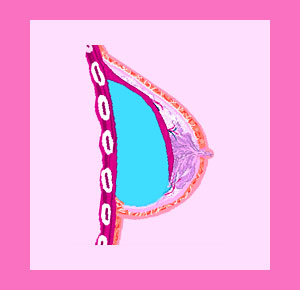
Saline implants almost single-handedly saved many cosmetic surgery practices in the United States. In 1992, the FDA outlawed the general use of silicone breast implants in the US, due to ongoing investigative studies concerning health problems associated with their usage. Now, silicone implants are once again legal in the US, but during the 15 years in between, saline breast implants truly changed the way breast enlargement surgery is performed.
This discussion examines the history and success of the saline-filled breast prosthetic.
Design of Saline Implants
Saline solution is a natural liquid made from sterilized salt and water. These are the very same compounds which make up a large portion of the organic human body.
Saline is a safe filler material for breast implants, since it is non-toxic and generally non-bioreactive.
The outer implant shell is made of a reinforced solid silicone material. The shells are thicker now than in years past, in the hopes of creating a longer lived and better performing implant.
Saline breast implants are very versatile, since they can be implanted in a variety of ways and placed in several distinct anatomical locations within the breast mound.
Saline Breast Implant Surgery
Saline breast implants are empty and folded when placed into the recipient. This allows for a far smaller operative incision than a comparably sized silicone breast implant.
The shell is placed into position, then filled precisely by the operating surgeon. The adjustable nature of the saline filled implant is a great tool for creating perfect symmetry in the patient’s breasts.
Saline prostheses are often used in patients with asymmetrical breast size or shape. Variations in natural size, shape, height and projection can be corrected at the last minute, on the operating table, using a visual inspection. This allows the cosmetic surgeon to have unrivaled aesthetic precision that is not afforded by silicone implants.
Saline Prosthesis Incisions
One of the biggest benefits of saline breast prostheses is the option of choosing from a number of possible implantation sites.
Saline, like silicone, can be implanted through a breast fold incision, called the inframammary approach, or through an incision at the bottom of the nipple, referred to as the periareolar approach.
Saline breast implants are also commonly placed through a small incision in the underarm, called the transaxillary approach, which is far more difficult to accomplish using silicone breast prosthetics.
Unique to saline breast augmentation is the ability for the implant to be positioned through a completely hidden incision in the belly button, called the transumbilical technique.
Versatile and Durable Saline Implants
Saline breast implants do not enjoy the widespread acclaim often lavished on silicone implants. This is true now more than ever, since silicone has been formed into a safe and natural prosthesis called cohesive gel.
However, saline is still a major contender in the United States market share of potential breast implant recipients.
Saline offers benefits which silicone can not touch and many doctors have perfected the art of scarless breast augmentation using these all-naturally filled cosmetic devices.
Just as silicone implants have evolved, look for new innovations in the saline breast implant industry in the coming years.



